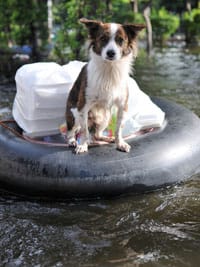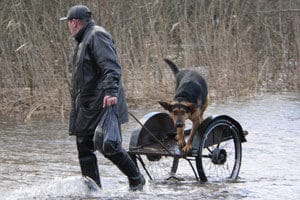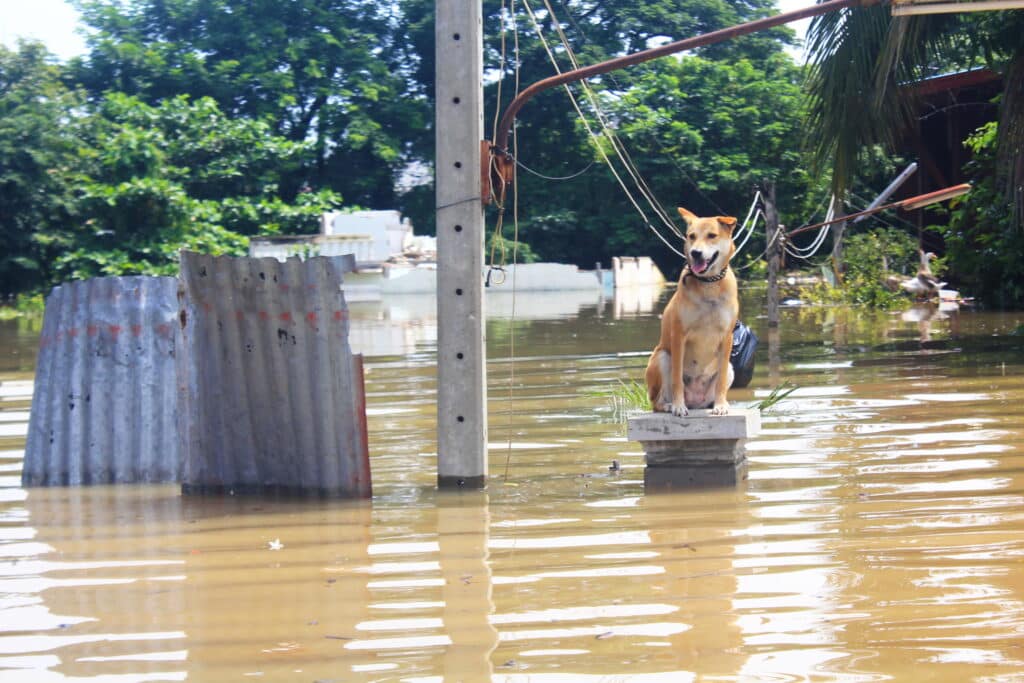
If a natural or human-triggered disaster strikes, what will you do with your pets?
When faced with an emergency situation, pet owners need to intervene on behalf of their dogs and cats to ensure their safety. How four-legged family members fare will depend on their preparedness, says Janell Matthies, emergency services manager for the United Animal Nations, a Sacramento, California based organization that brings animals out of crisis through a variety of programs, including emergency sheltering and disaster relief services.
“Animals can be affected by natural disasters in a number of ways,” Matthies says. “When they are left behind, they can starve, fall ill, become injured or drown, depending on the type of disaster. Even when animals are evacuated by their families, they can become extremely stressed. Animals can sense the increased tension that people put out. But when animals are evacuated appropriately, stress is decreased and the animals are usually able to adjust.”
Hurricanes, floods, fires, earthquakes, tornadoes, blizzards, even volcanic eruptions — not to mention human-triggered crises, like house fires, gas leaks, and terrorist threats — happen with little warning. If forced to evacuate or hunker down at home, unprepared dog owners may find themselves panicking.
With a little disaster preparedness and plan rehearsal, however, they can make sure their families — including their pets — survive the crisis together. Here’s how to prepare for a disaster, create a plan, and practice it to perfection.

Be Prepared
When it comes to preparedness, emergency management professionals have a saying: “If you fail to prepare, you’re preparing to fail,” says Ines de Pablo, a Washington D.C.-trained emergency management specialist based in Herndon, Va. Here’s how experts recommend you prepare:
ID, Please
Preparing for an unforeseen emergency or natural disaster begins with making sure your dog has her ID — microchip, tags or both — with her at all times, says Heather Case, DVM, director of the scientific activities division for the American Veterinary Medical Association. It should list current, updated information and, ideally, a cell phone number where you can be reached in case you and your pet separate during an evacuation.
Emergency Kit Ready
Matthies says your emergency to-go kit should contain things like a collapsible food and water bowl; extra harness, collar and leash; pick-up bags; temporary identification tags; pet first aid kit; airtight containers filled with at least 72 hours’ worth of food, water and medications; a properly sized kennel; and any other comfort items your dog will need.
List Your Emergency Contacts, Records
A list of emergency contacts — like your animal hospital’s phone number — as well as complete veterinary records and proof of dog ownership are critical, too, de Pablo says. “Pack all of your dog’s veterinary records, including proof of rabies, parvo, distemper and kennel cough vaccinations,” she says. “And also include multiple pictures of your entire family with the dog, as well as anyone else who you feel should be okayed to go to the co-location shelter and see the animal.”
Accommodations in Advance
In addition to gathering your emergency kit and veterinary records, you should also identify where you and your pet will stay in case of evacuation, Dr. Case says. Because the Red Cross cannot accept dogs in their evacuation facilities, you may need to find separate accommodations for your pet, like a boarding kennel, a pet friendly hotel or a dog-loving friend or family member’s place.
“Dog owners should develop framework in their plan first,” Dr. Cases advises. “And then you think about making sure the pets are identified, making sure you have all the vaccination records, and how you’re going to feed and water those animals in the temporary location.”
Once you’ve prepared your dog and your emergency kit, it’s time to formulate a plan of action.
Planning and Practice Are Everything
Experts agree — if not wholeheartedly emphasize — the importance of having a disaster preparedness plan of action, and the first part of it involves eyeing the real potential threats or dangers in your area. Different situations demand different responses, de Pablo says, so dog owners should plan for three different evacuation or emergency response scenarios:
Emergency evacuation with little or no notice: In a situation like a house fire or earthquake, you’ll need to grab only the most essential items — including your pets — and head to safety.
Emergency or voluntary evacuation where you’d have to leave your dog behind: Though far from ideal, de Pablo says, the situation may arise. If this happens, animals will rely on their survival instincts, but you can make it easier for them — and for first responders — if you leave an evacuation card tacked or nailed to your home, along with food and water for your pet, Dr. Case says. Never leave your dog chained outside.
A shelter-at-home situation: In a tornado or hurricane when you hunker down with your dog in your home, make sure you choose a safe room and stock it with essentials, de Pablo says, like food, water, a flashlight and other emergency essentials.
Once you’ve identified and prepared for these different emergency and evacuation scenarios, make sure to practice how you’ll execute your plan so you can remain cool and calm when disaster strikes, de Pablo says.
“The emergency management field has another saying: ‘An unrehearsed plan is a bad plan,’” she says. “Whether it’s a fire drill, an evacuation plan or a shelter-in-place plan, you should rehearse it because rehearsing makes it realistic.
Run through every step in your plan, de Pablo says. Time how long it takes your family to gather their emergency packs and meet at the car. Drive to evacuation centers, noting resources along the way. Know what you’ll do with your dog if you have to leave him behind. By practicing, you’ll be able to fill any holes in your plan and mitigate unforeseen problems, she says.
Though you can’t prevent natural disasters or emergencies from happening, you can be prepared for them. Identify threats, formulate a plan and practice what you’ll do if disaster strikes.
What is your plan to ensure your dog’s safety when disaster hits? Share it with us in the comments!











